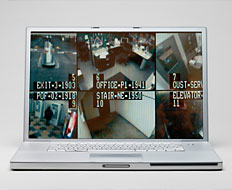We all know what a great tool video surveillance can be when it comes to loss prevention and employee safety. But network video—using IP-based cameras and monitoring software—can tell you far more about your business than who’s trying to rob the till. Viewed over time, network video surveillance can help uncover trends and patterns you can exploit to improve all phases of your quick-serve business.
Unlike proprietary DVR systems used in analog surveillance, network surveillance systems are based on open architecture, which means that not only can live and archived video be viewed through any Internet browser, but also dissimilar systems can be connected to collect and share restaurant data across departments. In other words, the restaurant can leverage the business intelligence captured by the network cameras, while at the same time having the ability to instantly share video with first responders (law enforcement, fire departments, etc.) for real-time situational awareness in an emergency situation.
Here are specific ways network video can help quick serves increase profits and streamline operations.
1. Deter Dishonest Employees. Tying network video surveillance into exception-based reporting can increase sales by 1 percent or more. Brands like Starbucks, KFC, Taco Bell, Panera Bread, and Caribou Coffee motivate more honest behavior in their employees by linking POS data with the corresponding video of each transaction. With less-than-honest employees, the video provides the hard evidence necessary to successfully prosecute the thief while making others think twice.
2. Avoid Accidents in the Workplace and Wrongful Worker’s Compensation. Given that the average worker’s compensation claim costs between $2,000 and $5,000, using network surveillance to improve workplace safety can have a significant impact on the bottom line.
Investing in higher-resolution network cameras rather than expensive DVRs provides more complete coverage of store activity. This enables management to see incidents that might otherwise have gone undetected and gain an accurate assessment of day-to-day operations at the store level. The recording can also be used as a teaching tool to improve store safety.
In the event of an alleged accident by an employee pursuing a worker’s compensation claim, the video record is the most effective tool available to learn what did or did not occur and whether the circumstances merit a challenge to the claim. With high-quality HDTV and megapixel video, what really happened is much clearer than the grainy analog video typically found in quick serves around the country.
3. Mitigate Fraudulent Liability Claims. Surveillance video also provides crucial evidence to mitigate the risk of fraudulent liability claims against your operation. We all know about the double-digit sales nosedive a popular quick serve took when accused of serving a human finger in its chili. It took old-fashioned investigative work to eventually bring the perpetrators of fraud to justice. But if network video surveillance of the event had been available, management could have searched the archives in a matter of seconds to reveal the falseness of the claim, avoiding a protracted public relations nightmare and saving the company millions in lost sales.
Again, investing in more network cameras with higher image clarity can make the difference in actually capturing what really occurred.
4. Run a Tight Ship with Operational Reviews. Management can also use network surveillance to remotely observe many different stores from one computer or mobile device and provide feedback on ways to enhance service quality, deploy its crew more efficiently, and monitor after-hours deliveries.
With the help of custom video analytics, sales and marketing managers can tap into the surveillance video to gather real-time data about customer ordering behavior, interactions with menus and displays, and length of time needed to place the order. Based on these observations, they could change the menuboard to increase customer throughput.
Another area where network surveillance can have a major impact on the bottom line is in alarm verification. If you allow your alarm company to log onto the video system to verify whether the alarm is a threat or not, you could avoid the stiff fines many municipalities impose for responding to false alarms.
5. Identify the Culprit with Facial Recognition. It’s not enough to catch the culprit on video. You need to put a name to the face. Many of the newest network cameras, with their megapixel and HDTV clarity, are uniquely suited for facial recognition analysis. Though still in its infancy, this emerging technology may soon make it possible to transmit the identity of a robber to security in seconds and share the recording of the incident in near real-time with police. This kind of immediate notification could lead to the quick capture and prosecution of the guilty parties, as well as better protection of your employees.












